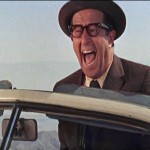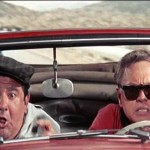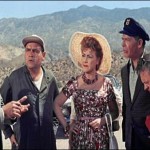Ask me my favorite movie moment and I’ll tell you a scene from It’s a Mad, Mad, Mad, Mad World. Before this morning I would have told it like this:
Phil Silvers and Jonathan Winters are in a private prop plane and the pilot has conked out. Silvers convinces Winters to take the wheel and fly the thing: “How hard could it be? Just put your hands there and there and your feet there. Now keep it steady while I go in the back and fix up an Old Fashioned like granddad used to make.”
Winters fumbles with the wheel and says, “What if something goes wrong?”
Silvers grins and shrugs, mugging a little for the camera. “What could go wrong with an Old Fashioned?”
It’s pure early-60s Tinseltown comedy: the oddball situation, the over-the-top response, the now-passe drinking humor, Phil “King of Chutzpah” Silvers playing a shtick nowhere to be seen in today’s Hollywood, and on top of that, breaking the fourth wall in a manner as old-fashioned as the cocktail he goes to prepare. All that’s missing is a Don Knotts double-take and someone getting trapped in a Murphy bed—both to be found elsewhere in the flick, of course.
One problem: the scene I just described is completely wrong. I’ve had it wrong for years.
I rewatched Mad, Mad World last night (finishing the second half this morning—it’s a long movie). Here’s how the scene really goes down:
Buddy Hackett and Mickey Rooney are in a private prop plane that Jim Backus is piloting. Backus finishes his Old Fashioned and tells Rooney to make him another, this time not so sweet. Rooney suggests that maybe two drinks are enough. Backus dismisses this and orders Hackett to fly the plane while he goes to the galley to make an Old Fashioned “the way dear old Dad used to.”
Hackett fumbles with the wheel and says, “What if something happens?”
Backus replies in his upper-crust voice, chin jutting out, “What could happen to an Old Fashioned?”
http://www.youtube.com/watch?v=2f1UPl8ANe4
As the cockpit scene started, I said to myself, “Wait, this isn’t it. When do Phil Silvers and Jonathan Winters charter a plane?” When Jim Backus is drinking Old Fashioneds, I thought, “This must foreshadow a scene to follow”—as though Mad, Mad World is some French New Wave masterpiece and not a Vaudeville crazy quilt of gags, farce, and one-liners.
It’s a pretty serious lapse on my part. I confused all the actors and the details of the situation. (Backus conks out after the exchange, when Hackett starts whipsawing the plane to and fro.) I’ve only caught bits and pieces of the movie on cable over the years. I doubt I’ve seen it in its entirety since the early 90s. I think I invented elements because those elements made so much sense. Phil Silvers is the best-cast actor of the whole film (yes, even over Spencer Tracy) because his shtick is so attuned to the movie’s cold worldview. It’s his con-man personality, his P. T. Barnum patter that verbally corners his victims into submission. (See some of it on display here.) He’s a natural fit for Mad, Mad World‘s winner-take-all tale of All-American greed. Silvers and Winters are at each others throats throughout the movie, so I paired them in the cockpit. Not that Backus wasn’t suited for the scene, or that Hackett and his Play-Doh face was a poor substitution for Winter’s thick-as-a-brick truck driver, but the pair I imagined in my head seemed so much better.
My most serious lapse was to goof the set-up and the punchline. “What if something happens?” turned into “What if something goes wrong?” “What could happen to an Old Fashioned?” became “What could go wrong with an Old Fashioned?” If you’re telling a joke and you botch the set-up and the punchline, you’ve failed. The joke can’t be salvaged. It’s not dead-on-arrival, it’s a miscarriage.
And yet whenever I told my version, people laughed. After watching Mad, Mad World my girlfriend said that my version was actually better. She’s not an unbiased judge, but you know what? I think she’s right. My version is better.
Mark Evanier’s retrospective of Mad, Mad World mentions a quote attributed to Ed Wynn: “A comedian is not someone who says funny things…a comedian is someone who says things funny.” That distinction is vital. So vital, in fact, I think that distinction should be taught in every creative writing class out there. The twist is, it is being taught, even if instructors don’t know it. Some might even deny it.
I think Wynn’s observation is that a comedian takes great care in selecting his words because the right language can make a joke great, just as they can a story or a poem. Poor decisions not only rob the joke of its humor, they can even make the joke not a joke. “Take my wife—please!” may not carry as much water as it once did, but “Will someone please get my wife the hell out of here” is simply Neanderthal crudity.
The beautiful sentence movement has grown so mainstream, it has its own movie. I say let’s start the beautiful joke movement—an appreciation of their structure, grammar, flow, and word choice.
A fiction writer with any interest in humor should study the craft of funny. (A fiction writer with no interest in humor should consider another pursuit.) Jokes are the original microfiction, the first short-shorts. At their best, they’re Western imitations of Zen koans, but when told right, both hands are clapping. Great jokes have a sturdiness to them, a similar sturdiness I find in great literature. Great jokes leak humor. It pours out from them in all directions. Often the blunt force of a joke’s initial contact—the impact that yields the first laugh, the rest of the laughs only arriving when the full implication of the punch line descends—often lay in a single phrase, or even a word. “Wrecked him? Damn near killed him!” is demolished when a novice repeats it as “Wrecked him? He almost died!”
Here’s my latest favorite joke:
How many Freudians does it take to change a light bulb?
Two: One to screw in the bulb and the other to hold my penis—my mother—the ladder!
Freud may be a genius, but his work forever linked his family name to screwing, dicks, and moms. Mrs. Freud must be so proud.
I know it’s odd to admit I’ve thought a lot about the words penis and mother in this joke. I hope you believe me when I say I’ve also considered what’s left out of this joke. With writing, addition can be subtractive:
How many Freudians does it take to change a light bulb?
Two: One to change the bulb and the other to hold my penis. I mean my mom! No, the ladder!
The funny is still there, but the unnecessary I mean and No stilt the delivery and ruin the impression of beating back the subconscious. The formal mother delivers a sense of matriarchal authority that mom lacks. Think how completely derailed this joke would be if dick was used in place of penis. And don’t overlook the loaded meaning of the missing screw.
And that’s why I prefer my cocktail debate over Mad, Mad World‘s. “What could happen to an Old Fashioned?” fits Backus’ old-money alcoholic because it places his primary concern with the well-being of the cocktail—but it doesn’t align with Hackett’s question, “What if something happens?” Backus should think Hackett is referring to the preparation of the drink, not the drink itself. The gag gets laughs because drunk pilots are always played for laughs. Its humor lies outside language and the characters’ subjective reality.
My version isn’t colossally superior, but it succeeds because Phil Silvers’ answer does align with Winters’ “What if something goes wrong?”—an Old Fashioned solves problems, ergo nothing can go wrong. His answer invites the audience in and makes them complicit in the joke—that is, the imaginary audience that never saw the joke that only existed in my head.
Now that I’ve amputated the funny bone from these gags (if you agree they had one) I head toward my liquor shelf asking myself the $350,000 question: What could go wrong with an Old Fashioned?


